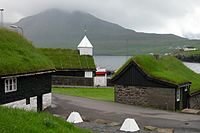Green roof
A green roof or living roof is a roof of a building that is partially or totally covered with plants. It may also include layers such as a root barrier and drainage and irrigation systems.[1] Container gardens on roofs, where plants are in pots, are not generally true green roofs. Although, this is debated. Rooftop ponds are another kind of green roof which are used to treat greywater.[2] Vegetation, soil, drainage layer, roof barrier and irrigation system make up a green roof.[3]




There are reasons why a building may have a green roof. The reasons include absorbing rainwater, providing insulation, creating a habitat for wildlife, increasing benevolence[4] and decreasing stress of the people around the roof, and helping to lower urban air temperatures and go against the heat island effect.[5] Green roofs are able to be added on old buildings as well as new buildings. They can be put on small garages or larger industrial, commercial and municipal buildings.[1] They effectively use the natural abilities of plants to filter water and treat air in urban and suburban areas.[6]
There are two types of green roof:
- intensive roofs: thicker, with a minimum depth of 12.8 cm (5.0 in). They can support many different kinds of plants, but they are heavier and require more maintenance.
- extensive roofs: shallow, ranging in depth from 2 cm (0.79 in) to 12.7 cm (5.0 in). They are lighter than intensive green roofs, and they don't need as much maintenance.[7]
References
change- ↑ 1.0 1.1 Rodriguez Droguett, B. (2011). Sustainability assessment of green infrastructure practices for stormwater management: A comparative emergy analysis (M.S.). Retrieved from https://www.proquest.com/docview/900864997
- ↑ Özyavuz, Murat, B. Karakaya, and D. G. Ertin. "The Effects of Green Roofs on Urban Ecosystems." GreenAge Symposium 2015.
- ↑ EPA (2017) Green Roofs. U.S. EPA. Available from: http://www.epa.gov/heatisland/strategies/greenroofs.html
- ↑ "Benefits of Green Roofs". www.greenroof.hrt.msu.edu. Archived from the original on 2018-07-04. Retrieved 2018-11-01.
- ↑ Vandermeulen, Valerie; Verspecht, A.; Vermeire, B.; Van Huylenbroeck, G.; Gellynck, X. (November 30, 2011). "The use of economic valuation to create public support for green infrastructure investments in urban areas". Landscape and Urban Planning. 103 (2): 198–206. doi:10.1016/j.landurbplan.2011.07.010.
- ↑ "System Overview : Planted Roof : GSA Sustainable Facilities Tool". sftool.gov.
- ↑ Volder, Astrid; Dvorak (February 2014). "Event size, substrate water content and vegetation affect storm water retention efficiency of an un-irrigated extensive green roof system in Central Texas". Sustainable Cities and Society. 10: 59–64. doi:10.1016/j.scs.2013.05.005.